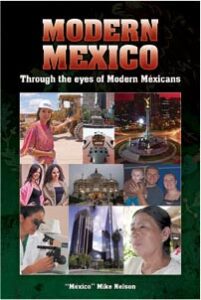This story about henequen production in Yucatan generates a surprising amount of interest, so, even though it is old, I leave it on the site. A teacher actually told me she uses it in class to teach writing. She did not say whether it was an example of good writing or bad writing and I did not ask. It was published in 1998.
Henequen is the past and the future of Yucatan, according to Jose Pinto Gonzalez, plant manager of the huge Cordemex henequen factory — largest of the three henequen factories left around Merida. Here, the raw fibers from the henequen cactus are shredded, pulled, wound together made into rope that varies in size from fine strands used for making hammocks, twine for baling hay, to hawsers the size of a man’s torso that tie ocean freighters to docks around the world. Individual strands are sewn together to make burlap bags. The factory produces 50,000 burlap bags a day, operating in two shifts, 6 AM to 2 PM and 2 PM to 10 PM, employing 500 workers. This is down from 5,000 during the 1980’s, when it was run by the government. The factory was privatized in 1990. Before privatization, workers were paid, even if they there was not enough work for them to do.
Sr. Pinto may be a little prejudiced, considering that his livelihood comes from the “green gold”, as the plant was called in its heyday. I found no one else who agreed with his assessment of the importance of henequen to the Yucatecan economy. In fact, Dr. Othon Baños Ramirez, director of the Unidad de Ciencias Social of the Centro de Investigaciones Regional who is acknowledged as the foremost authority on the subject, told me that it is a non-growth industry, although he does have some ideas for its future. Sr. Failure, whose family has owned Yaxcopil, once a magnificent henequen plantation, for generations has stopped raising it commercially. “There’s no future in it,” he said. The family hacienda has been turned into a museum and offers a brief glance into the faded past. If you stop here on the road to Uxmal, you’ll get a feeling for the days of henequen’s former glory.
Henequen (which has no relationship to hemp, although many people connect the two), comes from the agave cactus and looks like a green yucca. Other varieties of agave are used to make tequila. Henequen was used by the Mayas to make string, hammocks, crude clothing and rugs — not much has changed. The henequen boom, like the silver boom, transformed barren plots of land into acres of Eden. It wasn’t until the 1800’s that it came into its own. Factories were established and the end product was exported to the world. By the 1880’s, Yucatan into was one of the richest states in Mexico (although Yucatan has always considered itself apart from Mexico). Henequen made vast fortunes for the hacendados who cultivated it past the turn of the century. Yucatan produced ninety per cent of the rope and burlap bags used worldwide. The hacendados lived lives of wealth and privilege, like the silver barons in mountainous Mexico. Like silver, the industry declined after the first World War, due to the outbreak of the Mexican Revolution and the economic and political unrest of the period. It made a comeback during the second World War, but never got back to its prewar heyday. The advent of synthetics and the cultivation of the plant in Brazil, Madagascar, Tanzania and Manila combined to bring the industry to its knees.
Reviewing the stats of henequen production is like looking at a chart of a Wall Street or Bolsa bear market. 140,000 tons were produced in 1960 — the crescendo of modern henequen production in Yucatan. 73,00 tons were produced in 1970. 76,000 tons in 1980 came from 135,000 hectares. In 1990, 35,000 tons were produced from 55,003 hectares.. Current estimates put Mexico’s henequen production at about 28,000 tons. The cost of fiber increased forty-five per cent in 1994-95, but the price of the final product did not. The first fiber was imported from Brazil in 1989 and in 1994 8,000 tons were imported. This was due to a decline in productivity in the campo (there are about 6,000 mostly small growers) and an increase in demand. This year, there have been no imports from Brazil, due to three factors: it is politically unpopular, factories must pay in dollars, which is harder to do since the devaluation, and local production increased.
A new use for the fiber of sisal (another name for the plant) was developed in the 1970’s. It was made into rugs, but their colors faded and they were scratchy. A factory near Cordemex still turns the stringy fiber into what they call rugs, (alfombras) but are really wall hangings (tapetes). There must be some sort of trade secret there, because, it was the only factory which refused to let me in.
Ing. Manuel Vadillo Ramirez general manager of Fabrica Mayapan, took great pride in showing me the operation. He said, “Mayapan es una empresa joven y sisal un empresa antiqua.” The building is one of the oldest henequen factories in Merida and the company is the newest, founded in 1993. The new owners have completely remodeled the interior, installing machines made by the British manufacturer, James Mackie, to turn the raw fiber into finished product. It employs 185 people, pays more than the minimum wage, offers benefits to its workers and produces about 6,000 tons of finished products. November to May is the highest production period, because of demand in the United States for agricultural use.
The process takes four steps. Inside the airplane hanger shaped factory it sounds like a tunnel with a roaring locomotive. Man-sized bundles of raw, yellowish fiber are fed into machines that shred and sort the matted, stringy fibers. These are rolled into coils and dumped into multicolored fifty-five gallon drums, manhandled by sweating, burly workers onto an overhead conveyor that carries them, swaying and creaking, to the next level of separating machines that reduce the fiber to finer strands. As it moves up the chain in fineness, so does the air of the factory. At first the suspended fine dust, is like a light fog. Workers wear bandannas over their noses and mouths. By the end of the process, the air is breathable. At the last thrasher, metal teeth have sorted the tangled web into distinct strands of what will become twine, rope or burlap bags. It is labor intensive, as workers must constantly monitor the machines and often stop them in order to straighten out the wiry strands. After the stranding process is complete, the individual strands are fed into machines that wind them around to the desired thickness. Hammock use four or five strands; twine, ten or more, depending on the thickness; burlap bags are woven together using giant sewing machines. I couldn’t count the number of strands used to make the hawsers for ships.
Henequen’s attraction is its toughness and resiliency. It is strong enough to hold heavy items, and allows enough play that it will not break under conditions that snap synthetic ropes. The John Deere company has been one of the world’s largest buyers of henequen since it first became available. Its use for baling hay is unsurpassed. Attempts were made to use wire and nylon ropes, but cows ate the nylon and got sick, or cut their gums on the baling wire, or small pieces of it ended up in the cows’ stomachs. It’s not nice to fool Mother Nature.
Henequen’s future? While there will always be a demand for henequen products, new ones are unlikely. To cash in on the current trend towards Natural fabrics, clothing and rugs could be developed on a commercial scale — if a method were found to make the fiber finer and to hold color better. Dr. Baños, suggests two ways it can become a viable industry. Industry needs to find a way to raise the price of the fiber. This would seem to be difficult considering the worldwide competition. One problem is the low production in the campo. It would take an annual production of 36,000 to 40,000 tons annually to supply demand and a living wage for them. Since the individual producer shares very little in the profits of the industry, an incentive might increase production. If they formed cooperatives to sell directly to the international markets, which would encourage more production. This is likely to face strong opposition from the factory owners who argue that they are barely making a profit as it is.
Perhaps the best use of the henequen plantation today is to serve as a gateway to the romance of Yucatan’s history. Kancabachen, a magnificent ex-hacienda twenty minutes from Merida, puts on a show that is like a festival day on one of these fiefdoms. It has its own chapel, rodeo arena, zoo and families that work the fields. Employees operate a Rube Goldberg setup on the lawn that turns the raw fibers into twine and weaves these into ropes. Bloodless cockfights with betting, folkloric dances and a tour of the old hacienda with elegant archways, rocking chairs on the cool veranda, glorious paintings and faded photographs and decaying books in French, Spanish and English give you the feeling of the elegance and the pomp that was henequen’s heyday. Mayaland Tours can arrange a visit. If you really want to know more about the industry, Dr Jeff Brannon of UT El Paso has a comprehensive book called, Agrarian Reform and Public Enterprise in Mexico.




